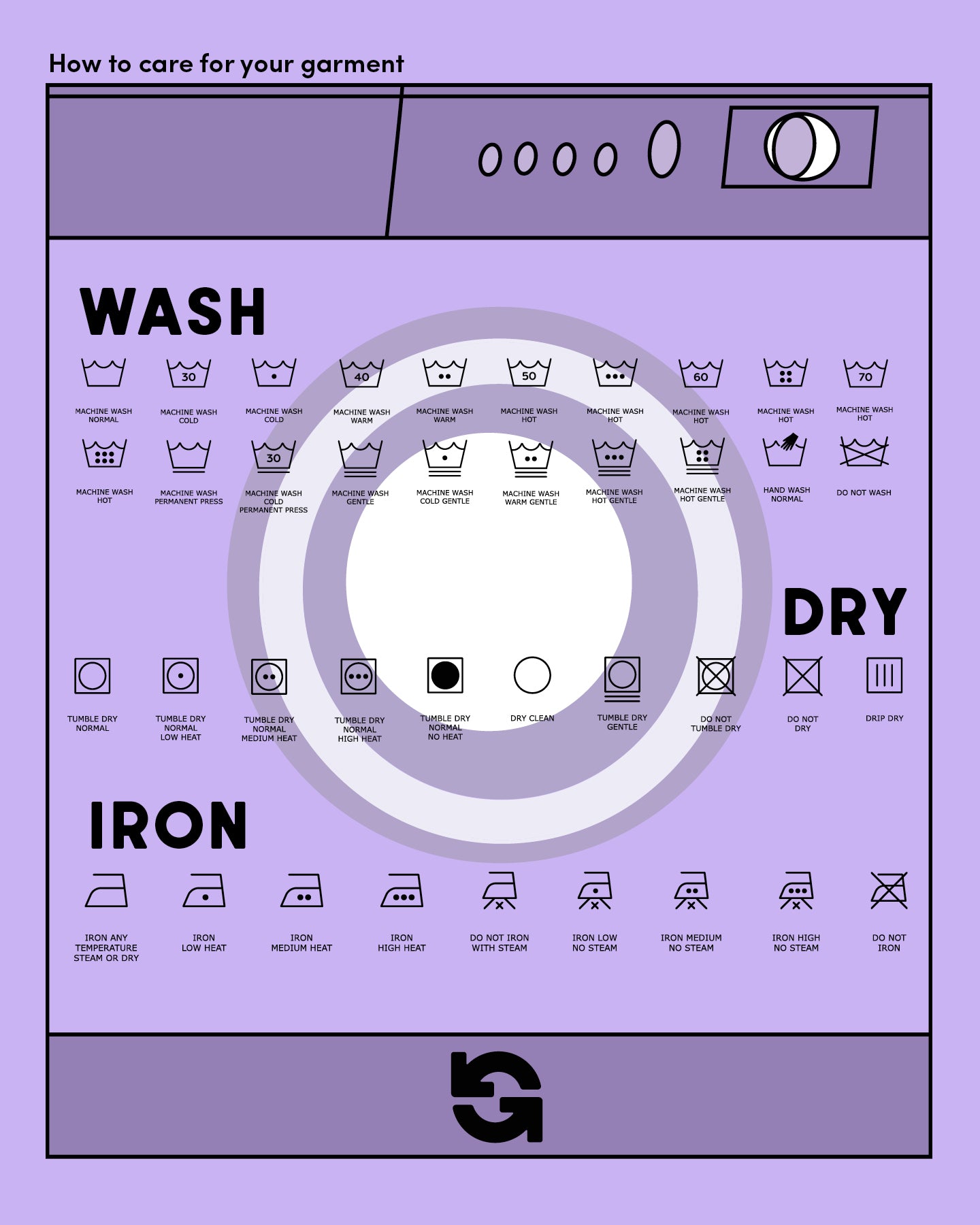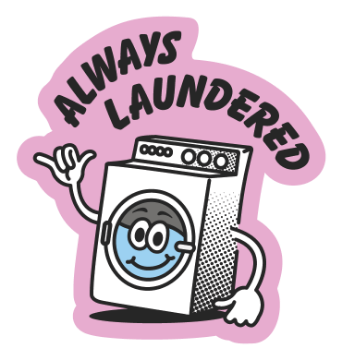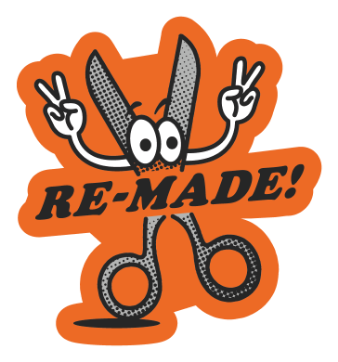Shopping vintage is a huge step you can take towards being a more eco-friendly consumer. However, taking care of your clothes is the next vital step for prolonging their lifespan, so that you can style your pieces up again and again. Glass Onion have provided you with the perfect guide for making sure your clothes are cared for correctly, by breaking down the labels you’ll find in your vintage pieces and explaining in detail what each washing symbols means.

Care Label History
The now standardised and globally recognised care labelling system for garments was introduced in 1963 with the establishment of GINETEX. GINETEX (International Association for Textile Care Labelling) was trademarked and opened its headquarters in Paris, with Switzerland as one of the founding countries.
Until the 1950s, care for garments was basic and simple, most textiles were made from natural fibres. The introduction of washing machines on the market allowed households to wash with two programs – a 95C for hot washes and 60C for non-colourfast dyed materials. In the beginning of the 1960s, however, industrialisation and globalisation of consumption meant a care language ought to be developed for all internationally. This is when GINETEX introduced its standard care label system, one which is continued to be used today. Adjustments and developments to the system are constantly introduced, however, the complications of textile care have largely been saved by this strategy of universal symbols.
Due to the 1970s rapid industrialisation, a trademark was put in place to protect the care label system from being diluted and effectively sending inaccurate information. The ISO (International Standardisation Organisation) have since been supporting the trademark which was subject to parallel development from the USA and Japan as the textile industry advanced.

What are the Different Types of Care Labels?
Care labels can be tricky to read at first, but we’ve got you covered with a detailed guide for each symbol so that you can care for your vintage, no matter what the material. By the end of this blog, we hope that you can learn what each of the care label symbols are used for and gain an understanding of what methods of care to apply to your pieces. Learning the care label symbols is really important to keep the colour, feel and durability of your clothes, so that you can keep them looking fresh in your wardrobe.
Washing Symbols
The Washing Symbols will be represented on your care label by a basin and water (or a tub with a wave line). This can be found on your care label to indicate whether garment is safe to wash and the different methods of how to do so. The washing symbol will appear in different formats: do not wash, hand wash and a 30C – 95C degree temperature range.
Most garments will be safe to wash. However, delicate materials such as silk, cashmere, hand knit, beaded or laced garments will in fact be marked with a hand wash or even do not wash icon to avoid shrinking.
If your clothes are machine washable, you will see a number in the tub to indicate the ideal wash temperature. This can range from 30C to 95C. Washing at a lower temperature than indicated can allow you to save energy. For oil and grease stains however, a higher temperature is more likely to remove.
Drying Symbols
Drying symbols can be a bit more tricky to understand, but are ultimately key in making sure you don’t stretch or shrink your clothes.
You can naturally dry or tumble dry clothes, depending on materials. Lycra, embellished clothing, suede or silk are just some examples of clothes that will display the ‘no tumble dry’ symbol on their care label. Other clothes made from materials such as polyester or cotton might however signify tumble drying at a higher temperature.
Ironing Symbols
An iron symbol will typically instruct levels of heat at which your clothes can be ironed, unless otherwise marked as prohibited for more delicate textures.
Professional Care Symbols
A variety of circular symbols on your care label have the purpose of suggesting whether your clothing requires professional care. This can represent dry cleaning, dry cleaning using a solvent, prohibited from dry cleaning or gentle care, to name a few.
Bleaching Symbols
Found in the shape of a triangle on your care label, the symbol for bleaching has the purpose of instructing how suitable your item is for this solution, that can be used in different levels.

Types of Washing Symbols
Here are the different formats in which the washing symbol may appear on your care label. They all suggest different ways of treating your clothing to avoid any possible damage, so read carefully.
Do not wash
If your washing symbol displays a cross through the tub, this means your item should not be washed, but instead may suggest dry cleaning.
Hand wash
A hand in the basin will indicate that your garment is safe to be handwashed, or at a 40C temperature in your washing machine if the symbol is displayed. To avoid shrinking, items with a handwash symbol should not be washed at a high temperature. You’re likely to find the handwash symbol on hand knit items, beaded or sequin clothing, clothing with lace and embellishments, silk and cashmere.
30°C very mild fine wash
A 30C very mild fine wash is ideal for your more delicate clothes. This is the lowest temperature you washing machine will offer.
30°C mild fine wash
A 30C mild fine wash can be used for clothes that might not require removal of harsh stains from oil and grease. You may find this on the care label for your wool and silk clothing.
30°C fine wash
30C is the instructed ideal temperature to help with saving energy and lowering your costs. A fine wash can do a great job in cleaning and freshening your basics.
40°C Very Mild Wash
This washing temperature will give you a higher chance of removing more prominent stains as well as bacteria, while also keeping damage to a minimum.
40°C Mild Wash
Washing at 40 degrees will help sanitise your clothes more thoroughly, although your washing machine might use more energy. Make sure to avoid washing delicate textures or dark colours at this temperature, to avoid damage to colour or fabric.
40°C Coloured Wash
You’re likely to find a 40 degree wash sign on items made from cotton, linen, viscose and acrylics. Coloured washes at this temperature will ensure your items are thoroughly disinfected, although we would advise to be mindful of any fading.
60°C Coloured Wash
If you’re concerned about your clothes holding any bacteria or viruses, a 60 degree wash is perfect. Items made from cotton or wool however could be at risk of shrinking at such a high temperature.
95°C Boil Wash
A boil wash is probably not something you would use often with your general clothing, we would recommend to no exceed 40 degrees for the purpose of a more greener life. However, this temperature is something recommended with the purpose of cleaning your washing machine, no more than every 3 months. 95C is also guaranteed to brighten whites and works great with items made from 100% cotton. Again, we strongly advise you keep temperatures as low as possible for your day to day cottons.

Types of Drying Symbols
Drying is an important symbol that you should correctly follow in order to prevent any possible shrinkage or stretching of your clothes. Understanding this symbol and its different variations, whether that be natural or tumble drying, will ensure your clothes have a longer lifespan.
Drip Flat Drying in The Shade
Drying in the shade can be found on your care label in the form of two diagonal, oblique lines inside a square. This sign will be in conjunction with “Drip Dry”. Drying in the shade will apply to clothes made from cotton, or coloured garments, to prevent fading.
Drip Line Drying in The Shade
Line drying will be instructed in the form of a semi-circle inside a square, and this is a symbol typically used for items such as trousers, knits or woven shirts.
Flat Drying in The Shade
Flat drying should be used for items made from natural fibres. This can be found on care labels for linen, silk, wool, leather and cotton.
Drip Flat Drying
Drip flat drying is a form of natural drying that prevents woollen, suede and nylon items from creasing and being misshaped.
Line Drying in The Shade
This drying process is different from drip line drying, as it involves wringing an item before hanging out. This should be done on materials that aren’t at risk of creasing, and never on delicate textures.
Flat Drying
The symbol for flat drying is represented by a horizontal bar inside a square. Flat drying prevents items from shrinking in a tumble dryer and also prevents consumption of energy.
Line Drying
Line drying is much more preferable than tumble drying. Hanging your clothes out does not only decrease the amount of energy you use in the process of cleaning your clothes, but also dramatically extends the lifetime of garments.
Drip Line Drying
Drip line drying cuts down on the need to iron, and if done in sunlight, can naturally bleach out any remaining stains on your whites.
Normal Drying Process
If you’re looking to save time, but also want to keep your clothes tidy, tumble drying might be the solution for you. A normal cycle tumble dry can be found on your care label as a circle inside a square. This suggests you should set your clothes to be dried at the hottest available setting.
Mild Drying Process
Mild drying may appear as a tumble dry sign with two bars underneath, with one dot inside the circle or with a shaded circle inside the square. This would indicate, in order, that your clothes should be tumble dried on a delicate/ gentle setting, at low heat or on a ‘no heat’ setting. This would apply, again, to more delicate fabrics.
Do Not Tumble Dry
This symbol will appear in the form of a crossed out circle and square, and will apply to silk, leather, wool, rayon cashmere, or any items that come in the from synthetic fibres.
Types of Ironing Symbols
This section will give you details about what clothing you should and shouldn’t iron, and the advised temperatures depending on fabrics.
Do Not Iron
The do not iron symbol would appear on your care label as a crossed out iron. You can typically find this on suede pieces, leather, spandex and even velvet.
Iron At Low Temperature
A low temperature iron symbol would be represented by an iron with a dot inside. This is usually 110C and is most suitable for acrylics and nylons.
Iron At Moderate Temperature
A moderate temperature iron symbol would be represented by an iron with two dots inside. This is typically 150C and is most suitable for wool and polyester.
Hot Iron
A hot temperature iron symbol would be represented by an iron with three dots inside. This is usually 200C (the maximum iron temperature) and is suitable for cottons and linens.

Types of Professional Care Symbols
Similarly to washing and drying, professional care is an important process to consider when it comes to cleaning your clothes. Here are the different symbols you might come across.
Do Not Dry-Clean
A crossed out circle symbol prohibits your item from being dry cleaned. Cotton, synthetic, denim or cashmere are some of the clothes on which you may find this care symbol.
Dry Clean Only
A circle symbol will signify that your item may be dry cleaned. If the circle contains letters A, F or P inside, they might come alongside instructions of what solvent should be used in this process.

Types of Bleaching Symbols
If you come across a triangular shape on your care label, this will represent methods of bleaching your clothes.
Any Bleach Allowed
A simple triangle signifies your clothes are safe for both chlorine and non-chlorine bleaching. Bleach typically works best on cotton and linen, but always double check your garment’s care label.
Do not bleach
A crossed triangle implies your clothing isn’t safe to be bleached. Wool, spandex and silk are some examples of textures that aren’t compatible with bleaching.

Meet The Team: Niall Dunn our Retail Stock Co-ordinator
Hi, I’m Niall and part of my role at Glass Onion is laundering our product for the retail channels we have: Website, Stores, and our UK wide Pop Up Events. On an average day I may launder up to 3,500 pieces of product dependent on what’s required on that day. For example, if we have a lot of tee’s, blouse, or lighter product my throughput is high. However, in winter when our product is heavier so: coats, jackets, and denim this figure is obviously lower. All the pieces that pass through me are hand selected by our mega grading team, which means I’m lucky enough to see some really cool pieces day in day out.

Once they are laundered it’s another QC check by me then on to the next department for processing. As part of laundering the garments, I have to pay close attention to the material of the piece and how the care label inside recommends it is cleaned. There is some really useful advice on this throughout this post. For our older and Rare pieces, I take extra care to ensure the garment is both as clean as it can be and in the best condition for our customers. This may mean I simply spot clean the garment to remove any stains, particularly with items that can only be cared for by dry cleaning. It’s these garments which strike the most interest with me as I’ve handled vintage Hermes, sample Dior pieces, Gucci and other iconic fashion labels, and they deserve the extra care that they receive.
My favourite part of my role, I’d have to say when a piece is in a particularly bad condition, and I spend some time on it to save it, it does give me a lot of satisfaction. I recently saved a load of old Nascar Tee’s which were in a bad state and would have otherwise been cut up for material. It’s great that we re-use garments in this way but it was satisfying to see them brought back to life in their original state.
In terms of the favourite items I’ve processed I think any of the 70’s-80’s sports brands we get through, so I’ve had some Fila BJ items which were mega and then lots of old “made in west Germany” Adidas which were also really cool pieces. Anyone will also tell you that I love a Burb Mac which we get plenty of. When we do it usually costs me some spending money that day!

Shop Hand Selected and Always Laundered
We hope to have given you an insightful guide into how to best care for your garments. Here at Glass Onion, our team works carefully to make sure your order is delivered in its best shape, and your vintage is looking and feeling fresh. We are confident that you’re now instructed with solutions to make your vintage as long lasting as possible, so that you can continue to style up your pieces for years to come! Shop the best vintage at our Events all across the UK and our Sheffield Store on Division Street.







